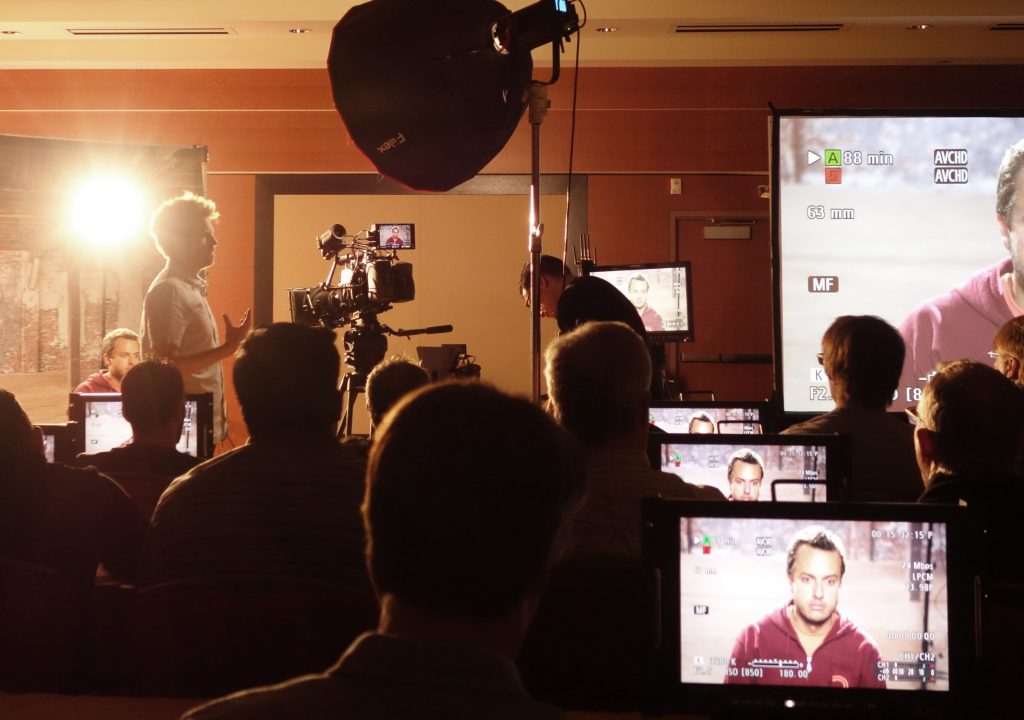I’ll be the first to admit that I’ve turned into someone who thinks everything I need to know can be found online. Whether it’s learning about something totally new or getting advice on how to make improvements around a topic I’m already familiar with, I instinctually believe there’s going to be an article, video or tutorial that tells me what I need to know. After all, when you can instantly watch the most commonly used hand signals for lighting technicians when they’re on a film set, it’s clear that we’ve crossed some sort of digital Rubicon.
Getting that kind of experience what struck me the most as I checked out one of the stops on Alex Buono’s Visual Storytelling 2 Tour. You probably know Alex from his role as the DP of the SNL Film Unit, where’s he’s worked on shorts like Hobbit Office and SNL Lincoln. He’s had a prolific career though, serving as DP on films such as Green Street Hooligans and Bigger, Stronger Faster. He started off as a camera assistant and learned from some legendary DP’s, so he’s someone who can speak from a place of knowledge and experience. The kind of insights and analysis you get from moving your way up the production ranks and from working under teachers like Conrad Hall and Dean Cundey are evident in everything Alex talks through and demonstrates during these tour stops.
Alex will pull up a shot or scene and simply ask, “How did we do this?” He then walks through the answer with diagrams, still photos and actual tools. It’s incredibly insightful, as he lays out his decision making process and gets specific about why he made one decision or another around details like LUTs, different lighting styles and choosing your lens, just to name a few. Sometimes when you watch a movie or TV show you think they must have access to some amazing and expensive tools that allow them to pull off certain looks and maneuvers, but it’s great to hear someone like Alex talk through how for the most part, the tools and techniques that he uses are ones that will be available to the vast majority of content creators.
Being able to simply raise your hand at any time and ask Alex something was impressive, because he’ll usually have an answer, but it can be even better when he doesn’t. During the presentation I attended someone asked him if a certain look he had created would have been possible to create on an iPhone, and the question was one Alex considered a bit before taking it as a challenge and seeing what he could do. That kind of on-the-spot problem solving is something to behold.
What was also interesting to see was Alex essentially go into a color grading session during the seminar. He’ll be the first to admit that what he can do with color on an NLE is very limited, but still thought it was worthwhile to explain the order of events that should be gone through. It goes back to the merging of production and post that we’re seeing everywhere, and not even people at his level can avoid those realities. It still has to be a collaborative process though, because as he literally said, you can’t just get there in post.
In the evening session, Alex went into detail around visual subtext. He prefaced the talk by saying the metaphors and motifs he’d be talking through and exploring from some famous films were things most people might not have ever noticed, but all of it was done with a purpose. Hearing those examples will make you reconsider what you’re seeing happening during some of your favorite films, and give you ideas around how that can impact your own narrative. If you’re ever watching a quality film or TV show and think one of the visuals was in there by accident, I’ve got news for you: it wasn’t.
What struck me the most about the show as a whole was that it laid out some essential information about big picture items while also digging into critical details that can ultimately help make or break a project. Alex talked through things like why set etiquette was so important, as well as what can happen when you hire the wrong crew or succumb to budget greed. On the other side of that, he got specific when it came to what apps he likes to use for location scouting, what sort of vintage lenses he used and plenty of other things that can immediately be utilized by content creators.
Click here to see when Alex Buono’s Visual Storytelling 2 Tour will be coming to your area.
Disclosure: My all access press pass was comped by the presenters of this tour.

